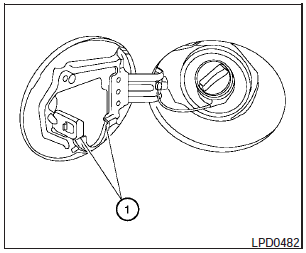Fuel-filler cap

The fuel-filler cap is a ratcheting type. Turn the cap counterclockwise to remove. To tighten, turn the cap clockwise until ratcheting clicks are heard.
Put the fuel-filler cap on the cap holder (1) while refueling.
WARNING:
- Gasoline is extremely flammable and highly explosive under certain conditions.
You could be burned or seriously injured if it is misused or mishandled.
Always stop the engine and do not smoke or allow open flames or sparks near the vehicle when refueling.
- Do not attempt to top off the fuel tank after the fuel pump nozzle shuts off automatically. Continued refueling may cause fuel overflow, resulting in fuel spray and possibly a fire.
- Use only an original equipment type fuel-filler cap as a replacement. It has a built-in safety valve needed for proper operation of the fuel system and emission control system. An incorrect cap can result in a serious malfunction and possible injury. It could also cause the malfunction indicator light to come on.
- Never pour fuel into the throttle body to attempt to start your vehicle.
- Do not fill a portable fuel container in the vehicle or trailer. Static electricity can cause an explosion of flammable liquid, vapor or gas in any vehicle or trailer. To reduce the risk of serious injury or death when filling portable fuel containers:
Always place the container on the ground when filling.
Do not use electronic devices when filling.
Keep the pump nozzle in contact with the container while you are filling it.
Use only approved portable fuel containers for flammable liquid.
CAUTION:
- If fuel is spilled on the vehicle body, flush it away with water to avoid paint damage.
- Insert the fuel-filler cap straight into the
fuel-filler tube, then tighten until the
fuel-filler cap clicks. Failure to tighten
the fuel-filler cap properly may cause
the  Malfunction Indicator
Light
(MIL) to illuminate. If the
Malfunction Indicator
Light
(MIL) to illuminate. If the  light
illuminates because the fuel-filler cap
is loose or missing, tighten or install the
cap and continue to drive the vehicle.
light
illuminates because the fuel-filler cap
is loose or missing, tighten or install the
cap and continue to drive the vehicle.
The  light should turn off
after a
few driving trips. If the
light should turn off
after a
few driving trips. If the  light
does not turn off after a few driving
trips, have the vehicle inspected by a
NISSAN dealer
- For additional information, see the
Malfunction Indicator Light (MIL) in
the Instruments and Controls section
in this manual.
light
does not turn off after a few driving
trips, have the vehicle inspected by a
NISSAN dealer
- For additional information, see the
Malfunction Indicator Light (MIL) in
the Instruments and Controls section
in this manual.
See also:
Displaying user guide
You can confirm how to use voice commands by
accessing a simplified User Guide, which contains
basic instructions and tutorials for several
voice commands.
1. Press the INFO button on the instru ...
Jump starting
If jump starting is necessary, see “Jump starting”
in the “In case of emergency” section of this
manual. If the engine does not start by jump
starting, the battery may have to be replaced.
...
Compact disc with MP3 or WMA (if so equipped)
Terms:
● MP3 — MP3 is short for Moving Pictures
Experts Group Audio Layer 3. MP3 is the
most well-known compressed digital audio
file format. This format allows for near “CD
quality ...
